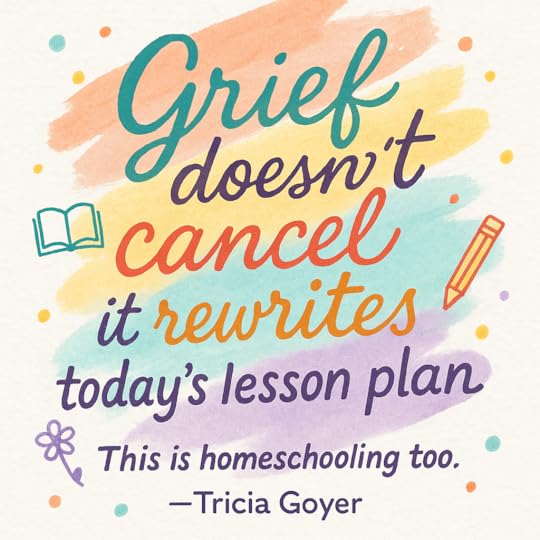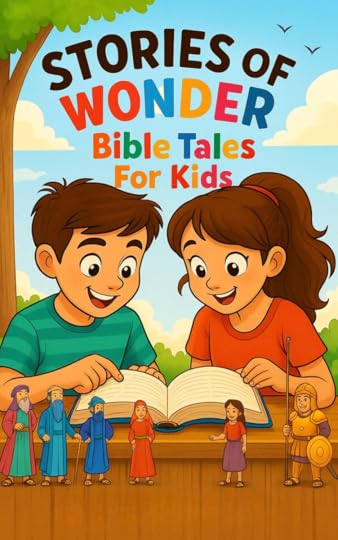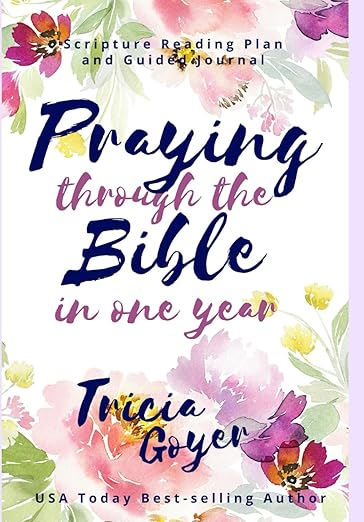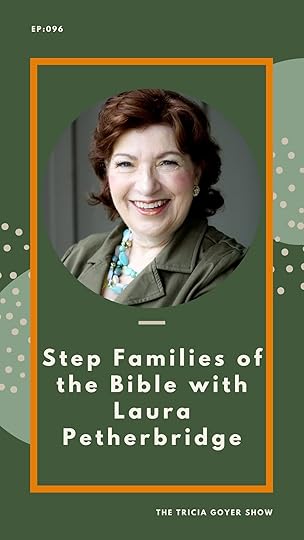Tricia Goyer's Blog, page 6
August 17, 2025
Writer’s Desk: Robin Jones Gunn
 Tricia Goyer
Tricia GoyerRobin Jones Gunn is the bestselling author of over 100 books with several award-winning fiction series including the timeless Christy Miller, Glenbrooke and Sisterchicks® novels. Her newest series is the bestselling Suitcase Sisters collection.
Robin’s popular nonfiction includes her memoir, Victim of Grace along with Praying for Your Future Husband co-authored with Tricia Goyer. She also has ten giftbooks and devotionals published along with fourteen children’s books and fifty articles. Sales of her diverse collection of books top 6.5 million copies.
Four Hallmark Christmas movies were created from her novels. The three Father Christmas films starring Erin Krakow, Niall Matter and Wendie Malick, premiered as the Most Watched and Highest Rated films on the Hallmark Movies and Mystery channel. A Glenbrooke Christmas, inspired by her novel, Secrets, re-airs frequently on the Hallmark channel.
Robin’s passion for speaking and teaching has taken her around the world where she’s keynoted in Africa, Brazil, Europe, England and Australia as well as Canada and throughout the US. Robin served on the Board of Media Associates International and currently co-hosts the popular Women Worth Knowing podcast and radio program with Cheryl Brodersen.
Many of Robin’s books have appeared multiple times on the ECPA bestseller list and have been both finalists and a winner of the Christy and Gold Medallion awards. She was honored to receive the Readers’ Choice Award twice from FHL of Romance Writers of America.
After living on Maui for a decade, Robin and her husband moved to southern California to be closer to family.n fiction.
Connect with Robin on her website, Instagram, Facebook, X, BookBub, and don’t forget to subscribe to her newsletter on her website.
More about Gelato at the VillaGrace and Claire have formed a close friendship over their love of reading. After many years and many books that provided armchair adventures, the time has come for them to go somewhere instead of only dreaming of someday.
Traveling to Venice, Florence, and Bellagio, the Suitcase Sisters find themselves immersed in the magnificent works of art, scrumptious gelato flavors, and endless pasta variations of Italy. And they discover a vulnerability to disclose their struggles in ways they never did at home. As Grace experiences a newfound freedom and confidence in who she is, Claire wrestles with painful memories of her teen years.
A special dinner party brings unexpected revelations about faith and God’s nearness. Then a life-changing moment on the shores of Lake Lugano causes Grace and Claire to discover they are not just tourists but pilgrims on a path to becoming all God created them to be.
Purchase a copy of Gelato at the Villa.
Enter to Win a Copy of Gelato at the VillaQ&A with Robin Jones GunnARCF: If you could describe Gelato at the Villa in one word, what would it be—and why?
RJG: Release.
Without realizing it, Claire and Grace have both been held back by issues in their lives that have kept them captive and stuck. Once they open their hearts to each other and are honest about the pain and problems they’ve kept hidden, they experience life-changing release.
ARCF: Was there a real-life trip, taste, or moment that inspired this story?
RJG: I’ve been to Italy twice and had lots of memories and notes to draw from. I’ve never taken a cooking class in Tuscany, though, so that part required lots of research. My husband got into doing the video research with me and we learned lots about pasta, Italian cooking techniques and lemons and tomatoes. Oh, and olive oil.
ARCF: Which came first for you: the villa, the gelato, or the characters?
RJG: The characters seem to always come first in my imagination. I cut pictures from magazines and create pages in a binder with details about the location and the details of my imaginary characters. About the same time as the location of Italy came to mind for this second Suitcase Sisters novel, I realized they had to stay in a renovated villa and again, movies and videos provided the details and inspiration. Gelato was one of my favorite memories from both treks to Northern Italy. The flavors, the rating system we set up for each one and the delight in finding a tiny place that had a flavor we hadn’t tried yet. Of course, the characters had to experience that!
ARCF: What flavor of gelato would your main character definitely choose—and what flavor would they avoid?
RJG: Both Grace and Claire became fond of the strawberry gelato that was created from strawberries in the garden at the villa.
The flavor that didn’t score highly for Grace was the hazelnut.
ARCF: Is the villa in the story based on a real place, or did it come straight from your imagination (or dream journal)?
RJG: The villa is a combination of two real places with some adjustments to fit the needs of the story. They had to have an important dinner under a portico dripping with wisteria so that was dreamed up. And the garden and pool at the villa came from pictures.
ARCF: If you could invite one of your characters to tour Italy with you, who would you choose—and why?
RJG: I would want to go with both Grace and Claire because they were such a great team and a balance of two different personalities that were fun to be around.

ARCF: You’re known for heartwarming and soul-nourishing stories—what’s the heart message behind this one?
RJG: God wants you back. You may have stepped away from the table, so to speak, but you are still His first love and He will never leave you or forsake you. I wanted to gently tell how two women can nurture a close friendship even when they are no longer coming from the same place because one of them has pulled back from what she once believed. I wanted to show how the Holy Spirit pursues each of us. For any women who are concerned about a friend who is walking away from her faith, Grace is an example of what unfailing love looks like and Claire shows readers how to wrestle with past hurts and emerge victorious over the most awful injustices.
ARCF: What’s one scene in the book that made you want to pack your bags and fly to Italy immediately?
RJG: Great question! I felt it when the women stepped into San Marcos Square and took in the basilica and campanile. They stopped walking and drew it all in. I remember the moment I did that for the first time as a 21-year-old while traveling with my girlfriends. My husband and I took our kids when they were in high school and we all had the same heart stopping moment. As I wrote about the gondola ride and the sunlight on the canal, I closed my eyes and felt I was right there. It was as if both trips had happened just yesterday. Ahhh. Venice.
ARCF: If the book had a travel playlist, what are one or two songs that would be on it?
RJG: Anything by Boccelli. Also, “monk music”, meaning the chants sung at vespers and recorded in an ancient cathedral. I have an assortment of those two that I played as I wrote.
ARCF: Was there a moment in the writing process when the story took a turn you didn’t expect?
RJG: Yes. I sent them to a small chapel at the top of the hill in the tiny village of San Mamete. I’ve stayed in San Mamete, on the lake, but we didn’t make it to the chapel and I always wondered what was inside. Some deep diving into YouTube produced videos of the chapel inside and out. When Grace and Claire entered and sat on a pew gazing at the art painted on the walls, a clear, new idea came to me and I changed the dialogue to go with the image they were seeing and discussing. It brought me to tears and I paused to settle a few things in my heart before concluding the chapter in an unexpected way. It was one of those times when it felt as if the Lord was doing what I asked Him to do before I started that book. He was leading me and showing me what He wanted readers to hear from Him through the story. His Spirit felt so close.
ARCF: How did your faith shape the emotional or spiritual journey in this story?
RJG: I relate strongly with both characters. The older I get, the more I am seeing how God healed me and is healing me from deep wounds in my teen years. I long for other women to be set free. I know God can restore and renew crushed spirits. My love for the Lord and my desire to see women healed was in my thoughts every day as I wrote.
ARCF: Which character do you think readers will fall in love with first—and why?
RJG: Maybe it will be the woman Grace and Claire meet in Venice – Paulina. She’s mysterious and generous and her quiet influence stays with them long after they return home. I also think some readers might relate immediately to Grace and her struggle at work and wish they, too, could step away from the stress and go take a gondola ride at sunset and jump on a Vespa and zip into a small village to get some gelato.
ARCF: What’s one quirky or unexpected detail you included in the story that most people might miss?
RJG: I love the legend a store clerk tells Grace and Claire on the island of Burano. I mention it on the final page of the book and hope readers will remember by the end of the book how Grace and Claire were mesmerized when they heard the tale in the lace shop.
ARCF: If this story had a scent, what would it be—a whiff of espresso, orange blossom, or old books in a sunlit room?
RJG: All of those fragrances and also the scent of garlic and fresh garden herbs from the kitchen at the villa. I think the abundance of spring flowers along the walkway and in the garden at Bellagio creates a familiar, ancient fragrance that hints at new life and fresh starts.
ARCF: If Gelato at the Villa were adapted into a movie, who would you cast as the leads?
RJG: Oooo. How fun that would be! I can’t come up with the two leads off the top of my head but after our amazing community of Avid Readers dive into the story, I think I’ll ask them to make suggestions.
ARCF: Have you ever had a gelato moment in your own life that felt like something out of a novel?
RJG: Yes! And I gave a proper nod to it when Grace and Claire are in Florence and find Gelateria Vivoli on Via Isola delle Stinche. My college girlfriends and I went there on our backpacking trip through Europe and quickly rated it the best of the best. (And we’d tried lots of gelato flavors on our journey.) That evening the sky, the fresh flavors, the sounds in the narrow street were all so, so memorable. It was a moment locked in time for all of us. A moment when we were in love with life and in awe of God and ready for whatever the future held. We still bring it up on our social media comments to each other. Whenever we wish that we didn’t live on different continents and could easily get together again, we say, “At least we’ll always have Vivoli’s!”
ARCF: If readers could take away just one feeling or truth after finishing the book, what do you hope it is?
RJG: One day, all will be made right. The Lord will vindicate you. You can trust Him. So, be at peace and live your life to the fullest.
ARCF: Which character would be most likely to get lost in a Tuscan market—and enjoy every second of it?
RJG: Claire. 100%. She almost did get lost. As a cook, she was enraptured with the variety of spices she discovered when they strolled through the mercato centrale. She wanted to take home a little of everything.
ARCF: Is there a quote or passage in the book that feels especially meaningful to you?
RJG: This quote from Grace at a critical moment:
What I did next was more important than I realized at the time.
I spoke kindly to my soul and told her, “Don’t be afraid.”
ARCF: Lastly, if you could teleport your readers to one scene in the book for a day, which one would it be—and what should they wear?
RJG: Come to the shore along Lake Lugano with Grace and Claire on their last morning. They’ll bring some extra pastry for you. You should bring a towel and a change of clothes. You’ll see why when you read the book.
ARCF: And finally, what is coming up next for you?
RJG: Suitcase Sisters Book 3 is in it’s final stages of edits and will release in 2026. Location and title will be revealed before long.
Save, Pin, Share

 The post Writer’s Desk: Robin Jones Gunn appeared first on Tricia Goyer.
The post Writer’s Desk: Robin Jones Gunn appeared first on Tricia Goyer.
August 15, 2025
UnTriggered with Amber Lia
 Tricia Goyer
Tricia GoyerListen to the episode with Amber Lia here.
About UnTriggered: 60 Days of Transformation for Moms Who Struggle with Anger
Amber Lia’s deepest desire was to be a good mom. But frustrations and anger often undermined her mothering. She was overwhelmed and recurringly triggered. Along with anger, she felt shame and discouragement.
But she was not alone. When she agreed to start an online group for moms with similar parenting triggers, she quickly discovered that thousands of moms felt just like her. Thank God He is able to restore weary hearts.
In UnTriggered, Amber shares encouragement for every mom longing for freedom from anger and the self-condemnation that often accompanies it. This sixty-day devotional touches on heart issues like releasing comparison with other moms, becoming a results-free mom, resisting comparison of children, gaining confidence in listening to the Holy Spirit, embracing the gift of motherhood, and more. Packed with spiritual encouragement, UnTriggered also includes easy “put it into practice” steps.
Your heavenly Father parents you with tenderness and patience. We can grow to be like Him. Join Amber Lia in this daily journey of releasing your anger and becoming a gentle, biblical parent. You can experience transformation and become untriggered.
Purchase a copy of UnTriggered: 60 Days of Transformation for Moms Who Struggle with Anger here.
Connect with Amber Lia
website | Facebook | Instagram
A former high school English teacher, Amber Lia is a work-at-home mom of four little boys ages 5 to 15. She and her husband, Guy, own Storehouse Media Group, a faith and family-friendly TV and Film production company in Chattanooga, TN. A certified independent health coach, Amber offers insight for all things health and wellness for anyone looking to live life to the full! When she’s not building sand castles with her boys on the beach, or searching for Nerf darts all over her house, you can find Amber writing to encourage families on her blog at AmberLia.com.
August 13, 2025
Turning Points of Modern History
 Tricia Goyer(And How to Make it Interesting for Teens!)
Tricia Goyer(And How to Make it Interesting for Teens!)I showed up to the first day of co-op with a tote bag full of… beans. Also sticky notes, yarn, and one crumpled printout of a WWI poster. Zero fancy slides. Zero shame. I took a breath, smiled at a row of teens in hoodies, and said, “If you were there at this point in history, what would you do?”
Thumbs popped up, sideways, down. They had opinions. Ten minutes later, these teens were stringing yarn across the room to show alliances, arguing (kindly) about promises and consequences, and writing one sticky note each: One thing I learned. One thing I’d do. I walked out grinning.
The cool thing is, you can teach your teens the same type of history lessons at home, without a fancy curriculum. You don’t need a perfect plan—just a repeatable rhythm and a bag of easy props.
History isn’t only what happened. It’s practice for who your teens are becoming.
Below is my story-friendly setup. Same flow every week. Minimal prep. Maximum smiles.
The Do-This-Every-Week Rhythm (60 minutes)Hook (5 min). Show a news report from history. Ask, “If you were there, what would you do? Do you agree with these actions?” Use thumbs up/side/down or A/U/D cards.An A/U/D card is a quick-response card students hold up to show their stance:
A = AgreeU = Unsure
D = Disagree
It’s just a fast, low-tech way to check understanding, spark discussion, and keep teens engaged.
How to make them (1 minute)
Write A, U, D big on three index cards (or one card with three sides: front/back + turn sideways).Optional: color code (green A, yellow U, red D).Done.Or have your student make them!Mini-Story + One Picture (10 min): Read a 90-second blurb and show one image on paper or your phone. Ask: What changed? Who paid / who benefited?Game / Life Lab (20 min): One hands-on activity (below).
Share It (15 min): 2–3 students give a 60-second show-and-tell. Class feedback in three words: Clear. True. Kind.
Exit Ticket (10 min): Sticky note: One thing I learned + One thing I’d do (if I lived then).
Your Tiny History Teacher ToteKeep the rhythm, keep it playful, keep it short.
[image error] index cards
[image error] sticky notes
[image error] markers
[image error] tape
[image error] string/yarn
[image error] plastic cups
[image error] a measuring spoon
[image error] dry beans or pennies
[image error] a stapler
[image error] a few printed pictures (or your phone)
[image error] a timer.
8 Plug-and-Play WeeksEach week gives you:
Story Blurb → Ask → Super-Simple Game → Home Idea
Use them in any order, or recycle favorites.
Blurb: “Families left farms for factories. Machines sped up production—but long hours and low pay reshaped home life.”
Ask: What improved? What got worse?
Game: Assembly-Line Challenge
Home Idea: Cook one meal “like 1850” (from scratch) vs. a 15-minute modern meal. List trade-offs.
2) World War I — Alliances & DominoesBlurb: “A local crisis in 1914 pulled in allies until the world was at war.”
Ask: How do promises help—and how can they trap?
Game: Yarn Web — toss yarn to “allies.” Snip one strand: what shakes?
Home Idea: Write a 3-sentence peace offer you’d try in 1914.
Blurb: “Banks failed. Jobs vanished. Families stretched every penny.”
Ask: What does a community need most when money is tight?
Game: Budget with Beans — 25 beans = dollars. Buy Rent 10, Food 8, Heat 5, Clothes 3, Fun 2, Give 2, Save 3. Choose 25 total; defend choices.
Home Idea: Plan a dinner under $10.
Blurb: “Posters, radio, and film tried to shape public opinion.”
Ask: What makes a message persuasive vs. manipulative?
Game: Poster Patrol — label tricks (fear, bandwagon, glittering words). Make a tiny truth poster for a modern issue.
Home Idea: Pause one commercial; name the trick.
Blurb: “The atomic bomb ended the war—and began new fears.”
Ask: How do we decide when all options have costs?
Game: Four Corners Ethics — corners = Drop Now / Demonstrate First / Don’t Use / Other Plan. One-sentence why; switch corners if persuaded.
Home Idea: Read a hibakusha quote; write one compassionate response.
Blurb: “Ordinary people in history used disciplined nonviolence to change unjust laws.”
Ask: Why did peaceful protest work?
Game: Bus Line Role-Play — tape a “bus.” Practice giving up a seat while stating rights calmly.
Home Idea: Write a 100-word letter to a local leader about one fair change.
Blurb: “Berlin split; allies airlifted supplies to keep hope alive.”
Ask: What keeps hope alive when life is fenced in?
Game: Airlift Drop — paper airplanes with paper-clipped “candy” must land inside a taped “city.” Debrief teamwork and persistence.
Home Idea: Secret “airlift” a treat + kind note to a neighbor.
Blurb: “Anyone can publish; not everything is true.”
Ask: How do you check a source fast?
Game: Source Race — give 3 short “facts” (one fishy). Teams mark C (credible) or Q (questionable) and jot one reason (author/date/evidence/bias).
Home Idea: Build a 2-source mini-bibliography on a topic you love.
Easy Grading (or none!)Star Chart: one star each for Prepared • Kind • Brave • Clear.Exit Sticky = Participation Credit.Hand out a ‘Historian of the Day’ sticker—instant morale.
Quick Tips for the History TeacherPrint one picture. Bring beans. You’re ready.
Set a phone timer so segments don’t drag.
Celebrate small wins out loud.
End every class with the same question: “What will you do with what you learned?”
Consistency beats complexity—every time. Make history a game with a point. Keep the rhythm playful and short, and your teens will lean in—while real-life skills sneak in through the fun.
Which history lesson week looks easiest to try first, and what two items will you toss into your tote right now so you’re ready?
Additional ResourcesHope and Refreshment for Homeschooling Parents
Need more ideas and advice on homeschooling? Pick up a copy of Homeschool Basics. Receive tried-and-true homeschool advice from veteran homeschooling moms Tricia Goyer and Kristi Clover. We dish out practical help on getting started and staying the course. Homeschool Basics will remind you that the best homeschooling starts with the heart. Packed with ideas to help you push aside your fears and raise kids who will grow to be life-long learners.
Kristi and I believe that homeschooling can transform your life, your home, and your family. Mostly, we believe homeschooling can truly prepare your children for the life God’s called them to live. Don’t let doubts hold you back any longer. Get Homeschool Basics on Amazon Now!
The post Turning Points of Modern History appeared first on Tricia Goyer.August 12, 2025
The Beauty in Your Undoing
 Tricia GoyerLetting God Rewrite You
Tricia GoyerLetting God Rewrite YouOne of the most beautiful—and painful—things about being a writer is the process of undoing.
To do my best, I must give my all. Writers know this. We pour our hearts into pages, confronting both our deepest doubts and our greatest hopes. But something else happens in the process that goes far beyond storytelling: God undoes us.
The Writer’s UndoingWhen I begin a new novel, I rarely feel confident. I never sit down to the keyboard with all the answers. I may know how a story starts—or even how it ends—but the middle? That part always requires wrestling.
And that wrestling is holy.
The doubts rise: Will this story matter? Will the words come? Will it be good enough?
The insecurities follow: Am I enough? Do I really know what I’m doing?
And yet, God meets me in that vulnerable space with gentle reminders that His strength is made perfect in my weakness.
“My grace is sufficient for you, for My strength is made perfect in weakness.”—2 Corinthians 12:9 (NKJV)
Each book I’ve written has chipped away at my pride, my self-sufficiency, my performance-based faith. Every word on the screen is a reminder that this calling is not about my ability, but about my dependence on Christ.
Where the New Name is Written“God writes our new name only on those places in our lives where He has erased our pride, self-sufficiency, and self-interest… A true disciple is one who has his new name written all over him—self-interest, pride, and self-sufficiency have been completely erased.”
Oswald Chambers – My Utmost for His Highest
That is my goal. Not just as a writer, but as a believer in Jesus.
And isn’t this the life of discipleship? Letting the Holy Spirit peel away the layers of “me” so Christ can shine through. In writing, that undoing is personal and sacred. When I sit in front of a blinking cursor, I feel exposed and needy. My words are not enough—but Jesus is.
“He must increase, but I must decrease.”—John 3:30 (ESV)Undoing Isn’t Just for Writers
Maybe you’re not a writer, but I wonder:
Where is God undoing you right now?What situation has you feeling weak, uncertain, or stretched too thin?What area of your life is He using to rewrite you?It could be a relationship that’s been tested, a job that feels overwhelming, or a dream that seems out of reach. It might even be in the quiet routines of motherhood, ministry, or caregiving—places where no one applauds, but God is powerfully at work.
“And I will give you a new heart, and a new spirit I will put within you.”—Ezekiel 36:26 (ESV)
God is doing something in your undoing. Don’t resist it. Lean in. Let Him rewrite you with grace, humility, and His divine love.
A Heart’s CryAs I sat down to write this today, the lyrics from the Newsboys’ worship song echoed in my heart:
“Come on, Lord, and fill up my life. I need Your presence, this is my heart’s desire…”
Yes, Lord. Fill every undone part of us. Let our hearts reflect Your glory.
A Prayer for the Undone HeartFather God,
Undo me. Erase the pride, the striving, the self-sufficiency. Fill every hollow space with Your truth and presence. I want my new name written across every part of my life, not just the areas that feel polished or acceptable. Use my weakness to reveal Your strength. Let my story—whatever You’re writing—point to You.
In Jesus’ name, Amen.
Let’s talk:
What has God used in your life to “undo” you and rewrite your heart?
How has that changed your walk with Him?
 Daily Bible Podcast
Daily Bible PodcastWe’re Tricia and Michelle, two friends inviting you to join us in reading through the Bible chronologically this year. Reading the Bible every day can be a challenge. We’re here to summarize each day’s passage and provide action steps … in under 15 minutes. Grab a buddy and join our community. Take the plunge, and let’s read through the Bible together. We’ll be cheering you on all the way!
Click here to get started, or find us on YouTube!The post The Beauty in Your Undoing appeared first on Tricia Goyer.August 11, 2025
Grief School
 Tricia GoyerWhen Lesson Plans Give Way to Loss—and Grace Becomes Your Curriculum
Tricia GoyerWhen Lesson Plans Give Way to Loss—and Grace Becomes Your CurriculumGrandmother slipped into eternity last week, less than two weeks before our first day of the new homeschooling year. I shuffled to the dining room where my planner was—the one color-coded with history timelines, literature read-alouds, and math facts—only to realize every task suddenly felt irrelevant. Tears blurred the pages. How do I homeschool when my heart feels split in two?
Maybe you’ve been there: a death in the family, a miscarriage, a medical crisis, or the slow ache of caring for an aging parent or grandparent. We say to ourselves, “I should keep the kids on track.”
Yet above that whisper, grief shouts, “Everything has changed.”
Friend, this messy middle ground doesn’t replace homeschooling. It is homeschooling. Our children are watching us live real life in real time. The lessons they learn as they watch us walk through hardship is something that will impact them for life. These are lessons are ones no curriculum can replicate.
5 Ways to Give Yourself (and Your Kids) Grace in Seasons of LossStepWhat It Looks LikeWhy It Matters1. Declare a “Selah Week.”Press pause on formal lessons. Read Psalms. Watch clouds. Light a candle and let everyone breathe.A holy pause teaches kids that hearts matter more than worksheets.2. Shrink the schedule to “Must-Dos.”Keep one main subject (maybe math) for familiarity. Let the rest of the time be filled with books, audiobooks, and nature walks.Predictability offers security, and space allows mourning.3. Invite help without apology.Text a friend: “Spelling is on hold—can my kids join your history lesson today?” Accept freezer meals from church. Invite a compassionate friend for coffee and don’t worry about the mess.Community reminds children that the Body of Christ shows up in practical ways.4. Turn memories into mini-projects.Have kids write Grandma’s favorite recipe, create a photo collage, or graph family heritage.Learning woven through grief honors the one you lost and keeps brains engaged gently.5. Model lament and hope.Read Lamentations 3:22-23 aloud, then pray together—even if your voice cracks.Kids discover that tears and trust can share the same sentence.Quick Scripts for Asking Help (Copy-Paste, Tweak to fit your situation, Send)Academics can pause, but discipleship never does. Grief becomes a classroom where grace takes the teacher’s chair.
 Text to a Co-Op Friend:
Text to a Co-Op Friend:“Hi, friend. We just lost my grandpa. Could my kids hop on your science lesson this week so I can handle funeral details?”
Email to Church Family:
“We’re navigating grief and still homeschooling. If anyone has a spare afternoon to read picture books to my littles or bring over flashcards, we’d be grateful.”
Note to Yourself (taped to the fridge):
“Permission granted to order pizza, skip handwriting, and stack cuddles higher than laundry.”
Reflecting on Grief in our Homeschool
Where is grief exposing your need for help, and who—if asked—would gladly shoulder a corner of that load?
Grief doesn’t cancel school. Instead, grief rewrites today’s lesson plan. When our children watch us trade perfection for just being together, our children learn the most essential equation: weakness + Jesus = enough.
A Prayer for the Grieving Homeschool MomFather of Compassion,
You see the empty chair at our table and the ache in my lesson planner. Thank You that You grade on grace, not performance. Help me lay down unrealistic expectations and pick up Your easy yoke. Send helpers who will love my children and feed our weary souls.
Lord, this is a hard season. May my tears become the ink that writes faith on their hearts. Teach us, together, that Your mercies really are new every morning. We need you now. Thank you for your presence. Amen.
So breathe, mama. Cancel the quiz if you must. Curl up with your kiddos and let Psalm 23 tutor every heart. THIS—the loving, grieving, leaning on Jesus together—is homeschooling, too.
Additional Resources Stories of Wonder: Bible Tales for Kids
Fun. Faith. A fresh view of the Bible—straight from the next generation of storytellers.
What do you get when you mix Bible stories, creative teenagers, and a whole lot of imagination? You get Stories of Wonder: Bible Stories for Kids. This book is packed with 27 fun, inspiring, and surprising retellings of Bible stories—from the big boat of Noah to a piglet in the Prodigal Son’s backyard!
Written by homeschooled teens in Tricia Goyer’s writing class, these stories bring old favorites to life in fresh new ways. And they give children beautiful glimpses of God’s care and love.
The post Grief School appeared first on Tricia Goyer.August 10, 2025
Move First
 Tricia GoyerThe Surprising Key to Getting Healthy and Following Your Dreams
Tricia GoyerThe Surprising Key to Getting Healthy and Following Your DreamsI hadn’t exercised in a while.
Honestly, I was showing up for everyone else—but not for me. Between coaching others, caring for family, and juggling life, I kept pushing my own movement to the bottom of the list. But then one day, I laced up my shoes and just moved.
Not far.
Not fast.
Just forward.
I did a short YouTube exercise video. Pretty simple. And then I did it the next day and the next.
And within a few days, I felt it:
Energy returning. Confidence rising. Clarity coming back.
That’s when this quote hit me like a holy nudge. I also came upon this quote:
“Change is only possible through movement.”
— The Art of Seeing
Isn’t that the truth? We say we want to feel better, think clearer, dream bigger, or live freer…
But first—we have to move.
It’s about momentum!
If you’re feeling stuck—whether it’s in your health journey or your dream journey, ask yourself:
Where can I move today?
Because movement isn’t just a workout. It’s an act of faith. It says, “God, I trust You enough to take the first step—even if I don’t see the finish line yet.”
Let’s Get Honest: Why We Stay StuckWe stay stuck because we’re tired. We stay stuck because we’re afraid. We stay stuck because we think everything has to change before we can start anything. But that’s not how breakthroughs work. Breakthroughs happen in motion.
It’s the walk around the block. The ten minutes of stretching. The “yes” to a water bottle instead of soda. The moment you say, “Okay, God—I’ll try again.”
The Same Is True for Your DreamsI talk to so many women who have big dreams sitting quietly in the corners of their hearts. They want to write a book. Start a ministry. Lead a health group. Mentor teen moms. Adopt. Run a race. Launch a podcast. Start a Bible study. But they’re waiting to feel ready.
Here’s a sticky truth: You won’t feel ready until you start moving.
That book idea won’t write itself. That calling won’t chase you down. That energy you’re longing for won’t magically appear. But move—and God will meet you in the motion.
You Were Made to MoveNot to hustle for approval. Not to earn your worth. But because there’s life on the other side of that stuck place. So today, I want to invite you to ask:
Where am I staying still when God is inviting me to move?
In my health?
In my habits?
In my calling?
Drink water first thing in the morning.
Text a friend your goal for today.
Pull out that old journal and write down the dream you’ve been ignoring.
Open your Bible and ask God what step He wants you to take.
Reach out to someone who’s a few steps ahead and ask for guidance.
Make a vision board and post it by your desk.
Say no to one thing that’s draining you and yes to one thing that gives you life.
Share your story—even if it feels messy. Someone else needs it.
Trust that forward is forward—even when it feels small.
Friend, if you’re ready to get unstuck, the key isn’t more thinking. It’s more moving. God isn’t waiting for you to have all your ducks in a row. He’s just waiting for your yes.
“For in Him we live and move and exist.”— Acts 17:28, NLT
Let’s move—toward health, toward purpose, and toward the dreams God planted deep in our hearts. You don’t have to do it alone. I’m here cheering you on.
Let’s move forward—together.
Would you like a health coach to help you move forward? My team and I would love to help!
Walk it Out
Whether believers realize it or not, God intended for them to do what the Bible says: adopt the orphan, take the gospel into all the world, and care for the needy. These are mandates that point believers down the path of true living and eternal life.
Sometimes those steps are easy, but many times they require a move outside of what feels safe or secure. When women stop focusing on their own dreams and purposes, and instead focus on God’s dreams and purposes, everything changes.
Get your copy of Walk it Out here!
 Praying Through the Bible in One Year
Praying Through the Bible in One YearHave you ever aspired to read the Bible from cover to cover, only to find yourself losing steam along the way? Or perhaps, after reading, you’ve wondered how its teachings relate to your everyday life. You’re not alone in this struggle.
Praying through the Bible in One Year is designed to help you experience this transformation for yourself. It provides a structured reading plan and daily prayer prompts, making the Bible’s wisdom applicable to your daily life. Join Tricia Goyer on this journey and unlock the door to life-changing inspiration.
Want more insight? Join us on the Daily Bible podcast!  LISTEN &
LISTEN &  WATCH
WATCH
 Introducing the Daily Bible Podcast
Introducing the Daily Bible Podcast Audio Player!

Immerse yourself in God’s Word like never before with the MegaVoice Daily Bible Podcast Audio Player—a solar-powered, portable way to listen to the entire NIV Bible and the Daily Bible Podcast with Tricia Goyer and Michelle Hill!
 Unplug & Listen – Step away from digital distractions and enjoy an uninterrupted discipleship experience.
Unplug & Listen – Step away from digital distractions and enjoy an uninterrupted discipleship experience. Simple & Accessible – With easy controls, it’s perfect for all ages, including kids, seniors, and the visually impaired.
Simple & Accessible – With easy controls, it’s perfect for all ages, including kids, seniors, and the visually impaired. Listen Anywhere, Anytime – Solar-powered with up to 14 hours of battery life, plus a USB charging option for cloudy days.
Listen Anywhere, Anytime – Solar-powered with up to 14 hours of battery life, plus a USB charging option for cloudy days.
 Whether you’re at home, on a mission trip, or enjoying quiet time in nature, this MegaVoice Audio Bible Player helps you stay connected to God’s Word—without a screen!
Whether you’re at home, on a mission trip, or enjoying quiet time in nature, this MegaVoice Audio Bible Player helps you stay connected to God’s Word—without a screen!
 Get yours today and experience the Bible in a whole new way!
Get yours today and experience the Bible in a whole new way!
Jeremiah 49:1-33, 2 Kings 24:5-9, 2 Chronicles 36:6-9, Jeremiah 22:24-23:32
 The Righteous Branch
Prophecies and Historical Context
The Righteous Branch
Prophecies and Historical ContextIn our reading today, we explore the prophecies in Jeremiah 49:1-33, the historical accounts in 2 Kings 24:5-7 and 2 Chronicles 36:6-8, and further prophetic declarations in Jeremiah 22:24-23:32. These passages highlight God’s sovereignty over nations, the consequences of disobedience, and the enduring promise of restoration through the Righteous Branch.
Judgment Against the NationsJeremiah 49:1-33 contains prophecies against various nations including the Ammonites, Edom, Damascus, Kedar, Hazor, and Elam. These prophecies emphasize that pride leads to downfall and that no nation can escape God’s judgment. Despite their power, these nations are destined to face destruction due to their defiance of God.
Historical Turmoil in Judah2 Kings 24:5-7 and 2 Chronicles 36:6-8 recount the reign of King Jehoiakim of Judah. After becoming a vassal to King Nebuchadnezzar of Babylon for three years, Jehoiakim rebels, leading to invasions and disasters. The Babylonians eventually capture him, and his son Jehoiachin takes over, only to continue the cycle of evil, resulting in further turmoil for Judah.
The Fall of Jehoiachin and the Promise of the BranchJeremiah 22:24-23:32 tells the story of Jehoiachin’s short and disastrous reign. God declares that Jehoiachin and his mother will be exiled and die in a foreign land, childless in terms of royal succession. Yet, amidst this dire prophecy, there is a promise of hope:
“For the time is coming when I will raise up a righteous descendant from King David’s line. He will be a King who rules with wisdom. He will do what is just and right throughout the land.” - Jeremiah 23:5This “Righteous Branch” refers to the Messiah, Jesus Christ, who would come to establish God’s kingdom and restore His people.
Word of the Day: BranchThe Symbolism of the BranchDefinition: A part of a tree which grows out from the trunk or from a bough; something extending from a main line or source. Symbolically, the Messiah.
The term “Branch” symbolizes the Messiah and is used throughout the Old Testament to point to Jesus:
A branch out of the root of the stem of Jesse (Isaiah 11:1)The “beautiful branch” (Isaiah 4:2)“Righteous Branch” (Jeremiah 23:5)“The Branch” (Zechariah 3:8; 6:12)The Hebrew word “tsemakh” (branch) and expressions like “sprout” and “spring forth” are messianic terms. Jesus, the Righteous Branch, sprouted from King David’s lineage to establish God’s kingdom on earth.
Remaining in the VineReflecting on these passages, we see a contrast between judgment and hope. The nations and kings who trusted in their own strength faced destruction, while the promise of the Righteous Branch offers restoration and righteousness.
In John 15:5, Jesus says:
“Yes, I am the vine; you are the branches. Those who remain in me, and I in them, will produce much fruit. For apart from me you can do nothing.”We are called to remain in Jesus, the true Vine, and through Him, we can bear fruit. Our connection to Him transforms our lives, turning barren branches into flourishing ones.
Embracing the Righteous BranchThe Righteous Branch is not just a promise for the future; it is a reality we can embrace today. By aligning our lives with Jesus, we partake in His righteousness and produce lasting fruit. Trust in Him, remain in His love, and let your life be a testament to the transformative power of the Righteous Branch.
August 12Jeremiah 23:33-40, Jeremiah 24:1-10, Jeremiah 29-30, 31:1-14
 The Challenge of Discerning the False
The Challenge of Discerning the False
In a world overflowing with information, distinguishing between what is true and false has never been more critical. This challenge is not new; the prophet Jeremiah faced it in his time as he confronted false prophets and deceitful voices among God’s people. Today, as we dive into Jeremiah 23:33-40, Jeremiah 24, and Jeremiah 29-31, we’ll explore the theme of falsehood and how we can navigate it in our lives.
Jeremiah’s Prophetic Warnings: False Prophets and Deceptive WordsJeremiah 23:33-40: In this passage, God instructs Jeremiah to rebuke those who falsely claim to speak for Him. The Lord is angered by the misuse of His words, highlighting the gravity of falsehood in spiritual matters.Jeremiah 24: Jeremiah’s vision of two baskets of figs symbolizes the distinction between genuine followers of God (the good figs) and those who deceive and are deceived (the bad figs). God promises restoration for the faithful exiles but declares judgment on those who remain in rebellion.Jeremiah 29: Through a letter to the exiles in Babylon, Jeremiah encourages them to settle and seek the city’s welfare, warning them against listening to false prophets. God’s plan for their future includes hope and restoration after a time of discipline.Word of the Day: FalseDefinition: Not according to truth or fact; incorrect.
This word serves as a reminder to be vigilant against deception, both in Jeremiah’s time and our own.
Navigating the False in Our LivesIn our journey through life, we often encounter what seems genuine but may be false. Jeremiah’s vision of figs and his warnings against false prophets remind us to discern truth from deception. Consider these areas:
Friendships and Relationships: Like fair-weather friends, some connections promise support but lack authenticity.Career Choices: In the pursuit of success, beware of false promises and unethical shortcuts that lead to emptiness.Spiritual Guidance: Seek God’s authentic voice and be cautious of voices that distract from His truth.Embracing the GenuineEmbracing what is real and genuine means learning to discern between good and bad figs, seeking wisdom in our choices, grounding ourselves in God’s Word, and resisting the world’s fleeting promises. Let Jeremiah’s message inspire you to pursue truth and authenticity in all aspects of life.
The Hope of RestorationDespite the presence of falsehood, Jeremiah’s prophecies also offer hope. God’s love is everlasting, and He promises to rebuild and restore His people. As we align with His truth, we can find peace, joy, and fulfillment in His promises.
August 13Jeremiah 31:15-40, Jeremiah 49:34-39, Jeremiah 50, 51:1-14
 Beauty in the WeepingRachel’s Tears and a Promise of Hope
Beauty in the WeepingRachel’s Tears and a Promise of HopeIn Jeremiah 31:15, we see Rachel weeping for her children, a symbol of sorrow over the loss of the people during the exile. Yet, God reassures them that there will be a return and reward for their work, indicating a future restoration. This promise of hope echoes throughout the chapter as God declares His everlasting love and commitment to His people.
A New Covenant of the HeartJeremiah 31 also introduces the concept of a new covenant. Unlike the old covenant written on stone, this one will be inscribed on the hearts of the people. This signifies a deep, personal relationship with God, where His law is not just followed but embraced internally. God promises forgiveness and an intimate knowing of Him, transcending mere obedience.
Word of the Day: WeepingDefinition: Expressing grief, sorrow, or any overwhelming emotion by shedding tears.
Weeping is a profound human emotion, a symbol of both anguish and longing for restoration.
Weeping Willows: The Beauty in GriefWeeping is often associated with sorrow and loss, yet there is beauty in this vulnerability. The weeping willow tree, known for its graceful branches that hang like tears, symbolizes both mourning and elegance. Similarly, there is beauty in a heart that weeps over sin, humbling itself before God.
Weeping in Our LivesWhen was the last time you wept? Reflect on moments of deep emotion, whether they were filled with sorrow or joy.Find beauty in vulnerability: Just as the weeping willow stands with grace, our tears can reflect a heart seeking after God.I recently wept seeing the decline of my grandmother, a dedicated Christ-follower whose life has deeply impacted mine. Despite the sorrow, I find hope in the promise of eternity with her. I also weep when I realize my own striving and need to refocus on Jesus, letting go of worldly pursuits and returning to His peace.
Babylon’s Destruction and Israel’s RestorationIn Jeremiah 50 and 51, God speaks of Babylon’s impending destruction, a symbol of His judgment against sin. Yet, intertwined with these warnings is a message of hope for Israel. A remnant will return, seeking the Lord with weeping, and God promises to preserve them.
The Righteous BranchJeremiah 31:15-17 speaks of a future hope when God will raise a righteous descendant from David’s line. This descendant will rule with justice and righteousness, offering safety and salvation to Judah. This prophecy points to Jesus, the ultimate fulfillment of God’s promise.
The Hope Found in TearsWeeping, though often associated with grief, can be a pathway to hope and restoration. God’s promises are steadfast, and in our tears, we can find beauty, strength, and hope through Jesus. Just as Judah will live in safety under a righteous ruler, we too can find security and a right relationship with God because of Jesus.
Let us embrace our tears as a testament to God’s enduring love and the hope of His promises. In our weeping, may we find the beauty of a heart turned towards Him, knowing that even in sorrow, God’s plans are sovereign and filled with purpose.
August 14Jeremiah 51:15-58, 1 Chronicles 3:10-16, 2 Chronicles 36:10-14, Jeremiah 52:1-3, 2 Kings 24:10-20, Jeremiah 37:1-10
 Understanding Vengeance
Hymn of Praise and Babylon’s Judgment
Understanding Vengeance
Hymn of Praise and Babylon’s JudgmentIn Jeremiah 51:15-58, we open with a hymn of praise to the Lord, acknowledging His power and wisdom in creating and preserving the earth. The passage quickly shifts to God’s declaration of vengeance against Babylon, a once-mighty empire destined for destruction. God’s judgment is severe; Babylon will be reduced to a desolate wasteland.
The Power of God’s JusticeThis section underscores God’s sovereignty over nations and His right to execute judgment. The imagery of Babylon’s downfall is stark, reminding us of God’s commitment to justice. The call for His people to flee Babylon emphasizes the urgency of escaping impending judgment.
The Downfall of Judah’s KingsAs we turn to the chronicles of Judah’s kings, we see the historical backdrop of God’s vengeance. King Nebuchadnezzar of Babylon takes King Jehoiachin captive, plundering the temple’s treasures and placing Zedekiah as a puppet king. Despite numerous warnings through prophets like Jeremiah, Zedekiah and the people remain defiant and disobedient, leading to Jerusalem’s eventual downfall.
The Consequences of DisobedienceThe repeated disobedience of Judah’s kings and people highlights the inevitable consequences of ignoring God’s commands. Zedekiah’s rebellion against Nebuchadnezzar, despite clear warnings, illustrates the pride and sin that provoke divine vengeance.
Word of the Day: VengeanceThis term is often misunderstood, yet it plays a significant role in our understanding of God’s justice. Vengeance is not simply revenge; it is a just retribution, a punishment for wrongdoing as decreed by God.
Understanding God’s VengeanceGod’s vengeance, as seen in these texts, is a demonstration of His justice. It serves as a reminder that He alone has the authority to judge and repay wrongdoing.
Have you ever felt the urge for revenge? How did it affect your heart and relationships?
When we hold onto a spirit of vengeance, it can lead to bitterness and personal ruin. The pain caused by others is real and valid, but our desire for revenge traps us in a cycle of anger and resentment.
Turning to God for JusticeThe key to healing is recognizing that vengeance belongs to God. We are called to forgive, not because the wrongs against us are acceptable, but because releasing them to God frees us from their hold.
Trusting in God’s JusticeForgiving others does not mean excusing their actions. It is about entrusting the situation to God and allowing Him to administer justice. By doing so, we are liberated from the burden of vengeance and open ourselves to God’s peace.
Practical Steps:Reflect on God’s Sovereignty: Trust that God sees all and will act in His perfect timing.Pray for Healing: Seek God’s help to release bitterness and embrace forgiveness.Pursue Justice with Compassion: When justice is needed, approach it without the intent for personal revenge.By trusting in God’s justice, we can navigate life with a heart free from vengeance, focusing instead on His love and peace.
August 15Jeremiah 37:11-21, Jeremiah 38, Ezekiel 1-2, 3:1-15
 A Prophet in a Time of Rebellion
Jeremiah’s Imprisonment and Perseverance
A Prophet in a Time of Rebellion
Jeremiah’s Imprisonment and PerseveranceIn Jeremiah 37:11-38:28, the prophet finds himself in the midst of political turmoil. Babylon has surrounded Jerusalem, and the city is on the brink of destruction. Despite the chaos, Jeremiah remains committed to his mission. Accused of defecting to the Babylonians, he is flogged and imprisoned. Yet, even in captivity, he continues to speak God’s truth, offering counsel to King Zedekiah.
The Cost of Speaking TruthJeremiah’s unwavering dedication to delivering God’s messages, despite facing imprisonment and threats, exemplifies the courage required to stand against rebellion. His story highlights the challenges of speaking truth in a world resistant to God’s guidance.
Ezekiel: Called to a Rebellious NationA Vision of God’s GloryEzekiel 1:1-3:15 introduces us to the prophet Ezekiel, living among exiles in Babylon. He receives a vision of God’s glory, witnessing divine creatures and a majestic throne. This encounter marks the beginning of Ezekiel’s prophetic mission to a rebellious nation.
Speaking to a Stubborn PeopleGod calls Ezekiel to deliver messages to the Israelites, despite their stubbornness and rebellion. Ezekiel is given a scroll to eat, symbolizing the message he must convey. Though the task is daunting, Ezekiel is empowered by God to speak boldly to a nation that refuses to listen.
Remaining Faithful in the Face of RebellionEzekiel’s story serves as a powerful reminder that even when faced with rebellion, we are called to share God’s word faithfully. His strength and resilience encourage us to remain steadfast, even when others are unwilling to listen.
Word of the Day: RebelDefinition: To reject, resist, or rise in arms against one’s government or ruler; to resist or rise against some authority, control, or tradition.
Our focus word speaks to those who revolt against authority, particularly against God’s commands. Through their stories, we see the consequences of rebellion and the unwavering commitment required to share God’s truth.
The Value of ResilienceStrong-Willed Resilience:
In both Jeremiah and Ezekiel’s stories, we see the importance of resilience and determination. God equipped Ezekiel with a strong will to withstand opposition and deliver His messages. This strength is a valuable trait, especially when surrounded by those who resist God’s truth.
Personal Reflection:
Reflect on moments when you’ve faced opposition or resistance in your efforts to share God’s message. How did you respond? What did you learn from those experiences?
Encouragement for Parents:
Raising strong-willed children can be challenging, but their determination can be a powerful tool for God’s work. Like Ezekiel, they can stand firm in their faith and resist the pressures of a rebellious world.
Listening and Learning:
Before sharing God’s messages, we must first let His words sink deep into our hearts. By internalizing His truth, we can effectively convey His love and guidance to others.
Faithfulness in Rebellion:
Jeremiah and Ezekiel’s stories remind us that even in times of widespread rebellion, God’s call remains. We are tasked with faithfully sharing His word, trusting in His plan and purpose.
Ezekiel 3:16-27, Ezekiel 4, Jeremiah 27-28, Jeremiah 51:59-64
 The Weight of Judgment
Ezekiel: A Watchman for IsraelThe Role of a Watchman
The Weight of Judgment
Ezekiel: A Watchman for IsraelThe Role of a WatchmanIn Ezekiel 3:16-27, God appoints Ezekiel as a “watchman” for the house of Israel. His responsibility is to warn the wicked of their ways, and he bears the burden of their fate if he fails to do so. The seriousness of this role highlights the weight of divine judgment and the prophet’s obligation to speak God’s truth.
Ezekiel’s role as a watchman emphasizes the importance of obedience and vigilance in sharing God’s messages, regardless of whether the people listen.
Symbolic Acts of JudgmentEzekiel 4 details a series of symbolic acts commanded by God to illustrate the coming judgment on Jerusalem. Ezekiel’s actions, including lying on his side for extended periods and eating a limited diet, vividly portray the consequences of Israel’s sins.
The lengths God goes to get His message across through Ezekiel remind us of the urgency and importance of heeding divine warnings.
Jeremiah: A Voice Against False ProphetsThe Yoke of ServitudeIn Jeremiah 27, God instructs Jeremiah to wear an ox yoke as a visual representation of the servitude that awaits the nations under Babylon’s rule. This symbolic act underscores God’s sovereignty and the futility of rebelling against His ordained judgment.
Jeremiah’s message warns against false prophets who offer false hope, emphasizing the need for discernment and obedience to God’s truth.
Confronting DeceptionJeremiah 28 records a confrontation between Jeremiah and the false prophet Hananiah, who falsely claims that Babylon’s oppression will end soon. Jeremiah warns that Hananiah’s lies lead people astray, and God’s judgment will be severe.
Jeremiah’s courage to speak against deception inspires us to uphold truth and resist the allure of false promises.
Word of the Day: JudgmentOur Role as WatchmenDefinition: The ability to judge, make a decision, or form an opinion objectively, authoritatively, and wisely, especially in matters affecting action; good sense; discretion; a misfortune regarded as inflicted by divine sentence, as for sin.
Understanding Our Responsibility:
Like Ezekiel and Jeremiah, we are called to be watchmen, sharing God’s truth and warnings with those around us. This requires discernment, courage, and faithfulness.
Reflect on Your Role:
Are you attentive to God’s whispers and willing to share His messages, even when they are difficult?
Judgment and Obedience:
The theme of judgment reminds us of the consequences of disobedience and the importance of aligning our lives with God’s will.
Seek God’s Voice:
Spend time in His Word to know His truth and differentiate it from personal desires.
Navigating Isolation:
Ezekiel experienced isolation as he fulfilled his role. Similarly, we may face seasons where we feel bound, yet God uses these times for His purposes.
Faithful in Small Things:
Embrace the opportunities to share God’s messages with those around you, trusting that your obedience has eternal significance.
Conversations That Matter:
I regularly engage in discussions with my adult daughter about media choices, holiness, and obedience. Though these conversations may not reach a large audience, they are crucial for her spiritual growth.
Encouragement for Parents:
God may call us to share His truth with those closest to us, and these moments are significant in His eyes. Let us be faithful in delivering His messages with truth and grace.
Looking Ahead:
While we may desire larger audiences, the focus should be on faithfully sharing God’s truth where He has placed us. Every act of obedience matters.
Ezekiel 5-9
 The Blossoming of Wickedness
Ezekiel’s Symbolic Acts of JudgmentA Message in Shaved Hair
The Blossoming of Wickedness
Ezekiel’s Symbolic Acts of JudgmentA Message in Shaved HairIn Ezekiel 5, God commands Ezekiel to shave his head and beard, dividing the hair into three parts to symbolize the three ways He will respond to Israel’s rebellion. Each part represents a different aspect of judgment:
One Third Burned: Symbolizes the destruction within Jerusalem.One Third Struck with the Sword: Represents those who will perish by violence.One Third Scattered to the Wind: Reflects those who will be exiled and dispersed.These acts illustrate the severity of God’s judgment against a nation that has defiled His temple and turned to idolatry.
Judgment on IsraelIn Ezekiel 7, the blossoming of wickedness and pride is depicted as a sardonic reversal. The nation’s sins have reached their peak, and disaster upon disaster awaits them. The poetic language conveys the inevitability and severity of the coming judgment.
The image of sin blossoming reminds us to examine our hearts for the seeds of pride and wickedness that may be taking root. Like a gardener, we must be vigilant in uprooting these weeds to prevent them from choking out the good in our lives.
Ezekiel’s Vision of AbominationIdolatry in the TempleIn Ezekiel 8, Ezekiel is taken in a vision to the temple, where he witnesses the abominations and idolatry committed by the Israelites. The chapter serves as an indictment against their spiritual adultery, highlighting the extent to which they have strayed from God.
The presence of idolatry within the temple itself underscores the gravity of Israel’s sin and the need for divine intervention.
The Mark of the RighteousIn Ezekiel 9, six men (possibly angels) are summoned, each with a deadly weapon, while a seventh man is tasked with marking the foreheads of those who mourn over the city’s abominations. These marked individuals will be spared from judgment, demonstrating God’s mercy amidst His wrath.
The act of marking the righteous emphasizes the importance of remaining faithful to God even in a corrupt world. It challenges us to stand firm in our beliefs and live lives that reflect His righteousness.
Word of the Day: BlossomedDefinition: To flourish or develop.
Our word today serves as a metaphor for the consequences of sin and pride. In these chapters, Ezekiel uses vivid imagery and symbolic acts to convey God’s judgment upon Israel and highlight the spiritual decay that has taken root.
Cultivating Spiritual GrowthExamining Our Hearts:
The imagery of sin blossoming calls us to reflect on the state of our hearts. Are we allowing pride and wickedness to take root, or are we cultivating a garden of humility and righteousness?
Pruning for Growth:
Like a gardener, ask God to reveal the areas of your life that need pruning and to help you remove the weeds of sin.
Blossoming in Adversity:
Despite the judgment, God promises to spare a remnant who will recognize their sin and turn back to Him. These individuals will blossom under His care, growing strong in their faith.
Welcome the Process:
Trust that God can transform your life, replacing the choking vines of sin with the fragrant blossoms of humility, kindness, and love.
Living Out Our Faith:
In a world where sin often seems to flourish, we are called to be watchmen of our own souls, discerning God’s truth and living it out with integrity.
Faithfulness in Small Things:
Whether speaking to a large audience or having conversations with loved ones, be faithful in sharing God’s messages with truth and grace.
Writer’s Desk with Adare Elyse
 Tricia Goyer
Tricia GoyerAdare Elyse writes middle grade and young adult fantasy and science fiction novels when she isn’t busy dressing in medieval costume, contriving puns with her clever husband, or singing showtunes to her little Shireling. Her work has earned multiple awards, including a Realm Award, and featured in various publications. Powered by tea and epic music, she draws inspiration from the nearby beautiful Rocky Mountains, her travels around the world, and her passion to share uplifting truth in fiction.isty Award-winning and bestselling author of stories that illuminate the ancient world of the Bible, in the hope her readers will dig deeper into the Word and encounter the Great Storyteller himself. A recent breast cancer survivor and adoptive mom of her two greatest gifts, she and her husband live in a small town south of Dallas, Texas.
Connect with Adare on her website, Instagram, Facebook, X, Goodreads, visit the world of On Hidden Wings & find out what fantasy race matches your personality, and get free homeschool curriculum here, and don’t forget to subscribe to her newsletter on her website.
More about On Hidden WingsFirst rule: hide your true self.
Becka‘s secret endangers her life. She’s a winged Centaur in a kingdom now systematically hunting all non-Humans to enslave them—or worse. Her one hope is to use her shapeshifting abilities to hide until her father returns to take her family to safety. But when the army closes in on her secret, Becka can’t wait anymore. If she doesn’t find her father now, she may lose him—or her chance to escape—forever. She’ll do anything to reunite her family—even break into the palace archives to discover her father’s fate.
The last thing she expects to find is a potential ally among the enemy. Locked away in his own castle, young Prince Ryandru also has a secret that has left him desperate for a friend. They’ll have to trust each other to discover the truth they both seek. But with traitors grasping for the throne and Becka’s family in jeopardy, revealing their secrets could destroy all they hold dear.
Jump into the adventure of this clean middle grade fantasy featuring forbidden friendship, accepting your unique self, and a world of mythical creatures including Fauns, Griffins, Pegasi, and more! A perfect choice for fans of The Chronicles of Narnia, Percy Jackson, and The Wingfeather Saga.
Purchase a copy of On Hidden Wings.
Enter to Win a Copy of On Hidden WingsQ&A with Adare ElyseARCF: Can you tell us a little about On Hidden Wings and share the inspiration behind it?
AE: On Hidden Wings is the story of a winged centaur girl hiding in a land where being a non-Human is illegal. She must use her shapeshifting skills to hide her true self until she can reunite with her father and get her family to safety. But in order to find him, she must break into the palace archives to find out what happened to him. The last thing she expects to find is friend in the prince, who has a secret of his own that has left him trapped in his own castle.
Becka is a character who has been flitting around in my head since I first started writing novels in middle school. She first showed up in a short story, and I kept trying to put her into other stories where she just didn’t fit. Finally, I decided to create a world around her so I could tell her story.
ARCF: On Hidden Wings features a winged centaur named Becka. What inspired you to choose a centaur as your protagonist?
AE: She’s a character that has been in my mind for a long time, and she’s unique in a lot of ways. There aren’t a lot of clean books with centaurs as main characters—you see them sometimes as side characters or in less savory subgenres. And I hadn’t seen anyone else with my idea of shapeshifting, where she can shift into any of her component forms or combinations thereof, such as just a human, bird, or horse, or even centaur, Pegasus, or Seraph. I’ve always loved horses, and there seemed to be a gap here where I could do something a little different than most of what’s out there.
ARCF: The novel introduces a richly detailed world with shapeshifting races. Can you share how you developed the unique abilities and cultures of the different species?
AE: I think the reason I’m drawn to mythical creatures like centaurs, griffins, and Pegasi is because I grew up with the Chronicles of Narnia where they weren’t monsters, but people. Each of these creatures have two components, and I thought it would fun for them to be able to shapeshift into each of these components and have a special connection to those animals. So for a Centaur, they could transform into a horse but also have some degree of special communication or kinship with horses. I also wanted them to be able to communicate with each other even in their non-human forms, and I wanted my races that don’t have a human component, like griffins and Pegasi, to be people who can communicate also, so they all have a kind of telepathic ability called heartspeaking. I knew this world had a divine creator, just like ours does, and in this world, he’s called the Lifegiver. In our world, we humans are made in the image of God, and that is a beautiful and important thing. I had to wrestle with what being made in the Creator’s image would mean in a world that has people groups that are part human or not human at all. There is so much more about God’s image than I can unpack since I’m not a theologian, but the one aspect I focused on was that we have a God who creates, and he allows us to create, too. Human races have hands and words that allow them to create and shape things in the world. For my non-human races, they use their hearts instead of their words and have a kind of magic, if you will, that goes along with it to shape the world. Griffins can affect the weather, and Pegasi can encourage life, such as in healing or growing plants.
ARCF: The story explores themes of identity and acceptance. How do you hope young readers will relate to Becka’s journey?
AE: I think Becka’s character really came out of my experience as a young person who was always very unpopular in school, the one who’s getting left out and picked on and who had very different beliefs from what was being taught in public school because of my Christian faith. Becka’s an outsider in her world because she’s a mixed-race child, the daughter of a Centaur and a Seraph, and that’s taboo. What I hope young readers will see in her journey is what I found in mine: that even if you don’t fit in, you are beautifully and intentionally created by a God who loves you, and you are the way that you are for a special reason.
ARCF: The novel is set in a kingdom that hunts non-Humans. How does this societal backdrop influence the characters’ actions and decisions?
AE: That is the driving force behind pretty much all the actions and interactions! Becka always has to hide who she truly is, which is very isolating in addition to the exterior stress of trying to avoid getting arrested and sent to some unknown fate, perhaps imprisonment, forced labor, deportation, or even death. The non-Humans in this story always have to be on the defensive. And on the flip side, you’ll see that some of them have also gone on the offensive to resist the Humans.

ARCF: The concept of “heartspeaking” is intriguing. Can you share about what inspired this form of communication, and what role does it play in the story?
AE: I guess I already dipped into this already, but heartspeaking is like telepathy but even deeper, because instead of relaying only words from mind to mind, it also can convey feelings. I have two non-linguistic races that don’t communicate in words at all, the Griffins and Pegasi, and for them heartspeaking relays images and emotions. When any of the races communicate with each other, they can understand it in the way their minds work, whether they’re a linguistic or non-linguistic race. Heartspeaking is key for my non-Human races because the Humans can’t heartspeak at all. The non-Humans can have whole conversations that the Humans can’t detect, which is incredibly helpful for the non-Humans who are pretending to be Humans. On the flip side, though, even the heartspeaking isn’t safe because there are some traitors out there who would turn in the other non-Humans they overhear for their own gain. I don’t want to give any spoilers, but Becka’s ability to heartspeak helps her discover a huge secret that shapes the whole rest of the story and the country.
ARCF: You’ve been writing for nearly 20 years. What kept you motivated to pursue publication, especially during challenging times?
AE: Ooh, I admit, it has been a very hard and discouraging road, and a couple of years ago I was in so much despair about how different my journey has been from what I wanted that God actually made me stop working on writing altogether so I could recover. I started writing novels when I was 12 and started pursuing publication at age 14, which I admit was too early because my first novels weren’t very good, but my dream by the time I got out of college was to be a full-time writer. I wrote 11 novels that I cycled through submitting to literary agents and publishers. I had friends along the way who I’d seen get impatient and self-publish before they were what I considered to be at the quality for traditional publishing, and I was so determined not to make that mistake that it became an issue of, “when will I be good enough?” I think a key part of God actually making me stop for about a year was to realize that I am not primarily a writer, I’m a child of God. He already thinks I’m good enough, and I don’t have to prove myself. I needed to trust that He was good and His plans were good enough for me. That’s what finally got me in position so that when he said to independently publish, I could go for it. And that’s why winning the Realm Award was so meaningful for me, because a small part of me still feared that my writing wasn’t good enough—and that award was a sign of His favor to me.
ARCF: On Hidden Wings was indie-published. What were some unexpected challenges and rewards of independent publishing?
AE: The big challenge of indie publishing is that you really have to be a small business owner, not just a writer, and that’s something I definitely dragged my heels on! You don’t have to make an official business like an LLC, but I decided to do that and file all the papers with the government and submit sales tax so I can sell my books at events. But as for the actual publishing part of it, I felt that God was telling me to get out the book that year in 2023, and it was already the end of July when I started, so I had to figure out how to do everything myself in a short amount of time. Next time I definitely want to give myself more of a lead time, because I didn’t even have my book cover back from the designer until the week before the release, which made any kind of advertising hard and preorders impossible. There were all kinds of little quirks like which distributors I could use in what order to get everyone to play nice with Amazon, and I literally called an author I had never met in tears to get her advice on some of those crazy little logistics that can keep the book from getting into readers’ hands. The hardest thing was that my step-daddy unexpectedly died about three weeks before the release, and I didn’t know if I should or even could go on, but I stuck with what I believed God was calling me to do. Because of all that, I really felt like my first book release was a huge failure instead of the wondrous moment that every author dreams of, and it was six months before I could even begin to celebrate the accomplishment. But as for the rewards, it’s really nice to have all the rights to my work so that I can make little tweaks at any time, like putting the Realm Award symbol on the cover, or do derivative works. I have a prequel short story that readers can get for free on my newsletter, and I was invited to create a free homeschool curriculum for it through New Classics Study Guides. I like the idea of doing more companion works like that in addition to sequels.
ARCF: You draw inspiration from the Rocky Mountains and your travels. How have these experiences shaped the world-building in your novel?
AE: To me, the Rocky Mountains are my default fantasy adventure setting, whether I’m reading or writing, since I grew up in the mountains in Colorado. The climate, the way the forests look, and the vistas are frequently much like Colorado. I didn’t realize how ingrained this was until my editor in Arizona asked why it was suddenly chilly when I mentioned the sun was setting in the summer, and I remembered that in an Arizona summer the middle of the night can still be blazing hot because it’s just a different kind of place! That said, I have had the privilege of traveling many places in Europe, which really expanded my worldview because of the different architecture and historical events that happened there and the different foods and languages. I imagine the capital city and palace to look a lot like places I went in England and Scotland. My favorite place I’ve been is New Zealand, because my sister and I just had to do the Lord of the Rings tour, and the dynamic landscape there is just so beautiful and inspiring. I also had a chance to go to China back in 2019, and while that hasn’t significantly influenced any of my stories yet, it really gave me a different view of people and governments and how cultural norms can be incredibly different, but with a little explanation a common understanding can be reached.
ARCF: The book has been compared to The Chronicles of Narnia and The Wingfeather Saga. What elements do you believe align your work with these classics?
AE: The Chronicles of Narnia is my go-to comparison, not because I am in any way saying I come close to Lewis’ brilliance, but because those stories were such an inspiration for the kinds of people in my world. My book also has a component of allegory, although it is pretty light since I want my work to be a crossover that’s approachable even by a secular audience. For the Wingfeather Saga, it’s mostly that both stories have a strong sense and value of family even as these young kids are going out and being brave independently on their own adventures to protect that family and keep it together. I will say the Wingfeather Saga has a much more humorous and whimsical tone than On Hidden Wings, but they are both good clean adventures that parents can feel safe sharing with the whole family.
ARCF: Faith plays a subtle yet significant role in the narrative. How do you weave spiritual themes into your storytelling?
AE: When I was first starting to write novels in middle school, most of what I read was general market fiction because that’s what was available to me and a lot of the Christian works I had read were very cheesy. But the general market books had a lot of darkness, and even the young adult genre that I gravitated toward as a safe genre didn’t stay a safe genre for very long—they were filled with a lot of darkness and hurtful content, too, that I wasn’t ready for. So I wanted to write for the general market clean stories that had hope and light. When someone presents an idea, especially a theological idea, in a non-fiction or real-world setting book, there’s a pressure to immediately accept or reject that idea. But in fantasy, it’s far enough removed from our world that we can examine these worldview ideas without having to make a decision right away. We can ponder, What if God is like this? What if the world is really like this? Stories can touch the heart and shine a light in a less confrontational way, and that’s what I love about fantasy. Since I came from that general market background, I don’t feel like I really write Christian fiction per se, but what I’ve found is writing a story without God in it just doesn’t make any sense. There is no basis for hope without God; it just doesn’t work. The other thing I’ve found is that most of the time I’m not intentionally putting a faith message into the book, but whatever God is teaching me at that point in my life gets woven into the story. I usually can’t even see it until I look back once the story is done and I have a little distance from whatever was happening in my life at the time. Back when I was writing On Hidden Wings, I was fairly new to hearing God’s voice, and he was taking me on a journey out of the bondage of perfectionism and fearing what others would think if I made a mistake by showing me how much he loved me, and that it wasn’t based on what I do but who He created me to be. In this story, Becka is really learning to accept who she is even though she’s different from everyone else, and how to find strength in who she was created to be.
ARCF: The characters face societal prejudice and personal secrets. What message do you hope readers take away regarding empathy and understanding?
AE: I feel like God makes my stories far more profound than I ever intend! But using my English major literary analysis toolkit to look at this book, I would hope that readers would see that a lot of pain and animosity comes from a lack of understanding that we’re more alike than we think, and that even in our differences, we are all created and loved by the same God, and we all have value because of that. I even have to do that in traffic when I see other drivers being rude to me: just take a breath and say this is a person God loves, and there’s probably a circumstance or hurt behind that behavior that I don’t know but God knows, and that takes all the steam out of my anger at them.
ARCF: Becka’s journey is both physical and emotional. How do you balance action with character development in your writing?
AE: You know, I’ve always been a plot-driven writer and reader, but as I’m growing up more (I still feel like a kid in a lot of ways), I’m appreciating more character-driven stories and realizing that the reason we want to read these adventures is because we care about the characters who are having them. We want to see how they learn and share in their triumphs. The physical journey may capture our interest, but it’s the emotional journey that captures our hearts.
ARCF: The novel emphasizes the importance of trust and friendship. How do these themes resonate with your personal values?
AE: Since I was the kind of kid who was a bit more of an outsider, I had just a few friends that I deeply connected with, and as long as I had them with me, it didn’t matter how many people I had against me. It is so precious to have people you can truly confide in who can counsel you wisely and share your experiences. For some people that circle is bigger than for others, but regardless of size, it is so vital. You really can’t have that kind of relationship without trust, and to have trust you need people who are truthful and safe, who will handle your heart with respect and gentleness.
ARCF: Looking back, is there anything you would have done differently in the writing or publishing process?
AE: Definitely would have given myself more time to publish! I still haven’t gotten around to the marketing I should have and maybe still should be doing for this book, but I believe since I haven’t had the bandwidth to do that justice, God has been my promotion team with special blessings like being on this podcast! For writing overall, I wish I had had less of a failure mindset, that if I wasn’t getting an agent or a contract or a contest win that it was still good experience rather than a failure. That’s still something I’m trying to learn.
ARCF: What advice would you offer to aspiring writers, especially those interested in the fantasy genre?
AE: I have always been the kind of person who doesn’t want to have to rely on other people—that’s another area where God is helping me grow—so this might sound weird coming from a lone wolf like me, but find your writing community. Critique groups can be so helpful for improving your craft and inspiring new ideas, or even just nerding out over the same kinds of books can be so enlivening. The other good community-finder option is writing conferences. You can learn so much about writing at conferences and connect with other writers. For me, I didn’t really find that community where I fit until I found Realm Makers, and they get me. In the Christian conferences, I was usually one of the only fantasy writers among people who ranged from not seeing the appeal to thinking it was borderline heresy, and at secular fantasy conferences, the authors had a very different vision for their writing careers and what books should be like. Realm Makers was that perfect fit of people who actually understand what I’m talking about and have the same values. I found my editor because she and I were riding the same shuttle to the airport back from Realm Makers. I actually took her card to give to someone else and then ended up hiring her later for my book!
ARCF: If On Hidden Wings was optioned for film, who would your dream cast be?
AE: Oh dear, I don’t think I can answer this one because I don’t keep up with actor names! While it might make a really cool live action film, I almost think it might be better as an animated film, and I definitely can’t put a name to voice actors! Whatever character they were playing in the first movie I saw them or the movie I watched the most is what I call most of them.
ARCF: And finally, can you share what’s coming up next for you?
AE: I have been on a bit of a maternity leave since I just had my first child in December. An author friend gave me some wonderful advice, which was not to put any pressure on myself to write for six months after the baby came but just let it flow if it does, because having a baby is a huge life change! So, I’m just now getting back to writing and have been dreaming up all kinds of projects. The one I know for sure is that I’m going to write a sequel for On Hidden Wings. It is important to me as a reader that the first book in a series is satisfying enough that it could be a standalone, so that’s what I did with my book, but there are some things that people have been curious about and more I can develop, so that’s my main goal for the next writing project.
Save, Pin, Share

 The post Writer’s Desk with Adare Elyse appeared first on Tricia Goyer.
The post Writer’s Desk with Adare Elyse appeared first on Tricia Goyer.
August 8, 2025
Step Families of the Bible with Laura Petherbridge
 Tricia Goyer
Tricia GoyerListen to the episode with Laura Petherbridge here.
About Stepfamilies of the Bible: Timeless Wisdom for Blended Families
Blending families isn’t easy—but hope and guidance can be found in scripture. In Stepfamilies of the Bible blended family expert and stepmom, Laura Petherbridge offers heartfelt insights and solutions for navigating the complex emotions, relationships, and challenges of today’s blended families. Through inspiring true stories of God’s heroes from stepfamilies, discover practical tools to build unity, overcome complexities, foster love, and rely on faith during every step of the journey.
This powerful healing resource is the entire blended family, not merely couples. It’s designed for anyone currently in—or related to—a blended family. Laura provides encouragement, wisdom, and God’s grace. Begin your journey today!
Purchase a copy of Stepfamilies of the Bible: Timeless Wisdom for Blended Families here.
Connect with Laura Petherbridge
website | Facebook | Instagram
Laura Petherbridge serves couples and single adults with topics on spiritual growth, relationships, stepfamilies, co-parenting, single parenting, divorce prevention, and divorce recovery.
She is an international speaker and author of four books including, When “I Do” Becomes “I Don’t”—Practical Steps for Healing During Separation and Divorce, and The Smart Stepmom, co-authored with stepfamily expert Ron Deal and endorsed by Gary Chapman (Five Love Languages), 101Tips for The Smart Stepmom—Expert Advice from One Stepmom to Another and Quiet Moments for the Stepmom Soul-a devotional.
Laura has spoken at the Billy Graham Training Center, and for Lifeway, Family Life, Hearts at Home, and Iron Sharpens Iron conferences.
The post Step Families of the Bible with Laura Petherbridge appeared first on Tricia Goyer.August 6, 2025
Creating “Aha!” Moments in Your Homeschool
 Tricia Goyer
Tricia GoyerThere’s something incredible about the “Aha!” moment—that flash of clarity when something finally makes sense. Maybe it’s solving a tricky math problem, watching a science experiment bubble over, or understanding a powerful truth in God’s Word. Those moments stick with us—and as homeschool parents, we have the joy of creating those moments every day.
The beauty of homeschooling isn’t just in the academics. It’s in the wonder. It’s in cultivating curious hearts and pointing our kids to the One who wired their brains for discovery. Psalm 19:1 says, “The heavens declare the glory of God; the skies proclaim the work of His hands.” The entire world around us is a living lesson plan authored by the Creator.
Whether you’re a brand-new homeschooler or a seasoned parent juggling multiple grades and caregiving responsibilities (like I am with ten kids and caregiving for parents and grandparents!), you can build beautiful “Aha!” moments into your everyday rhythm. Here are seven ways to cultivate faith, connection, and curiosity in your homeschool.
1. Create Time to Spend with the CreatorStart your homeschool day by gathering together for a short devotional. This practice centers your family in God’s presence and sets the tone for the day. You don’t need to be perfect—you just need to be present. Make time in your schedule for Scripture, prayer, and quiet moments with God.
“Be still, and know that I am God.” —Psalm 46:102. Choose a Format that Fits Your FamilyDevotionals don’t have to be long to be meaningful. With little ones, 15–20 minutes is plenty—read a short story, ask one question, and say a prayer. With older kids, aim for discussion. Let them wrestle with hard questions and dig deeper.
Great tools include:
Jesus Storybook Bible (younger kids) Indescribable: 100 Devotions About God & Science by Louie Giglio Faith and Science with Dr. Fizzlebop by Brock Eastman Foundations: 12 Biblical Truths to Shape a Family by Troy and Ruth Chou Simons Whit’s End Mealtime Devotions by Crystal Bowman and Tricia Goyer3. Remind Your Kids—and Yourself—We All Learn from Each OtherEncourage your children to ask questions, share insights, and even lead parts of your devotional time. Some of my most powerful “Aha!” moments have come from the mouths of my kids. The Holy Spirit uses them to teach me, too.
4. Read Scripture Stories TogetherRead aloud from the Bible, take turns acting out a story, or compare versions. Afterward, ask:
Where did you see God in this story?How did He respond to people?What does this teach us about His character?These simple questions open space for reflection and connection.
5. Add a Hands-On ActivityTry a science experiment, object lesson, or craft tied to your reading. Faith and Science with Dr. Fizzlebop offers 52 experiments with short devotionals for each—perfect for weekly family learning.
Examples include:
Exploring density with oil and water (to explain sin and redemption)Making invisible ink (to explore what’s hidden vs. revealed by God)6. Let Questions Lead the WayDon’t worry if you don’t have all the answers! Respond with, “Let’s find out together.” Let your kids see you seek truth. That example builds a lifelong hunger for God’s wisdom.
“If any of you lacks wisdom, let him ask God, who gives generously to all…” —James 1:57. Pray Together—Out Loud and OftenInvite the Holy Spirit into your school day. Take turns praying over each other’s needs, joys, and even frustrations. Let your children see that God is involved in every part of life—from math tests to sibling squabbles.
Encouragement for New Homeschool ParentsIf you’re just beginning this homeschool journey, welcome! You don’t have to have it all figured out. You simply have to be faithful. Every story you read, prayer you whisper, or experiment you try plants seeds of truth in your children’s hearts. God will water and grow them in His time.
“Train up a child in the way he should go, and when he is old he will not depart from it.” —Proverbs 22:6A Final WordHomeschooling gives you the freedom to learn together, worship together, and discover God’s wonders in everyday life. Whether you’re conducting fizzing science experiments or just sitting together at the table with open Bibles, remember this:
You are creating a culture of faith, one “Aha!” moment at a time.
A Prayer for Your HomeschoolLord, thank You for the gift of learning alongside our children. Help us to cultivate wonder, wisdom, and worship in our homeschool. May our days be full of grace and our hearts anchored in Your truth. Guide our words, our lessons, and our laughter. We entrust this season to You. Amen.
What’s been your favorite “Aha!” moment with your homeschool kids? Share in the comments—we’d love to hear your story!
Additional ResourcesWant to create more faith-filled learning moments in your homeschool?
Hope and Refreshment for Homeschooling Parents
Need more ideas and advice on homeschooling? Pick up a copy of Homeschool Basics. Receive tried-and-true homeschool advice from veteran homeschooling moms Tricia Goyer and Kristi Clover. We dish out practical help on getting started and staying the course. Homeschool Basics will remind you that the best homeschooling starts with the heart. Packed with ideas to help you push aside your fears and raise kids who will grow to be life-long learners. Kristi and I believe that homeschooling can transform your life, your home, and your family. Mostly, we believe homeschooling can truly prepare your children for the life God’s called them to live. Don’t let doubts hold you back any longer. Get Homeschool Basics on Amazon Now!
The post Creating “Aha!” Moments in Your Homeschool appeared first on Tricia Goyer.August 5, 2025
More Dreams. More Attempts. More Life.
 Tricia Goyer
Tricia Goyer“As far as I can tell, every great advance — whether in an individual life or the world at large — has come from dreams and attempts.”
— James Clear
I read that quote this morning and had to pause. Dreams. Attempts. That’s the simple recipe for a great life. But what stops us?
For many of us, it’s not a lack of ideas. It’s a lack of showing up. Here are four things that try to keep us stuck. And four ways to push forward with God.
4 Things That Keep Us Stuck1. Fear: “What if I fail?”
We often fear that we’ll fail, but not even trying is not success. You’re already losing the battle you refuse to fight.
Let’s be honest: fear is a master manipulator. We tell ourselves it’s safer not to try. Not to risk embarrassment. Not to hope too much. But the truth? Not trying is its own kind of failure. Staying stuck is choosing stagnation over potential.
“For God has not given us a spirit of fear and timidity, but of power, love, and self-discipline.”—2 Timothy 1:7 (NLT)
Your dreams don’t need to be loud or flashy. They just need a willing heart. Even one step forward is a step out of fear.
2. Weariness: “I don’t have the energy.” We don’t have energy because we sit instead of trying. Yet the weary cycle keeps us stuck.
Motion brings momentum. Movement brings motivation.
I get it. When you’re tired—physically, emotionally, spiritually—it’s hard to dream. But what if the weariness is partly because you haven’t moved toward what fuels your soul?
Maybe it’s not that you’re too tired to dream. Maybe you’re tired because you haven’t been dreaming.
Even the smallest act toward a dream—clearing out your pantry, writing one sentence, walking ten minutes—can revive your spirit.
“Come to me, all of you who are weary and carry heavy burdens, and I will give you rest.”—Matthew 11:28 (NLT)
Moving toward Jesus and asking Him to help you start allows faith to grow.
3. Confusion: “Who even am I?” Sometimes we don’t know what to even try or how to dream.
You can’t chase your purpose if you’re distracted by everyone else’s.
We’re constantly comparing. Her success. His platform. Their perfect life. But you weren’t made to live their story. You were handcrafted by God to live yours.
“For we are God’s masterpiece. He has created us anew in Christ Jesus, so we can do the good things he planned for us long ago.”—Ephesians 2:10 (NLT)
You weren’t created to numb out on snacks, scrolls, or self-doubt. You were created to live awake.
I’ve watched people light up from the inside out—not because they found a perfect diet or the “right” routine, but because they stopped numbing and started noticing. They let go of shame and leaned into God’s design. And yes, many of them started by saying no to sugar and yes to life.
4. Doubt: “Can God really help me?” That’s the wrong question. Instead what if we asked, “God, I know you can help me. Start with helping me to trust you more.”
God can’t direct a parked car. Start driving. He’ll steer.
God isn’t waiting for you to have it all together. He’s just waiting for you to show up. One small ‘yes’ today can open a hundred doors tomorrow.
“Commit your actions to the Lord, and your plans will succeed.”—Proverbs 16:3 (NLT)
That doesn’t mean everything will be easy. But it does mean you won’t walk alone.
Dream. Attempt. Trust God.Final Word: Don’t Settle. Show Up. You don’t need to be perfect. You don’t need to have all the answers. But you do need to move.
And if you need help? I’m here. As a health coach, as an author, as someone who’s stumbled and gotten back up more times than I can count.
But this blog isn’t about me. It’s about you showing up to the life God has for you. So start today. One attempt. One dream. One step toward the person you were always meant to be.
You won’t regret it.
If your dream is to get healthy, my team and I offer free health coaching to help you get started.
Additional ResourcesIf you enjoyed this post, you may also like these:
When Food Is No Longer My Refuge
Small Steps Matter
How Your Thoughts Shape Your Health and LifeThe post More Dreams. More Attempts. More Life. appeared first on Tricia Goyer.



